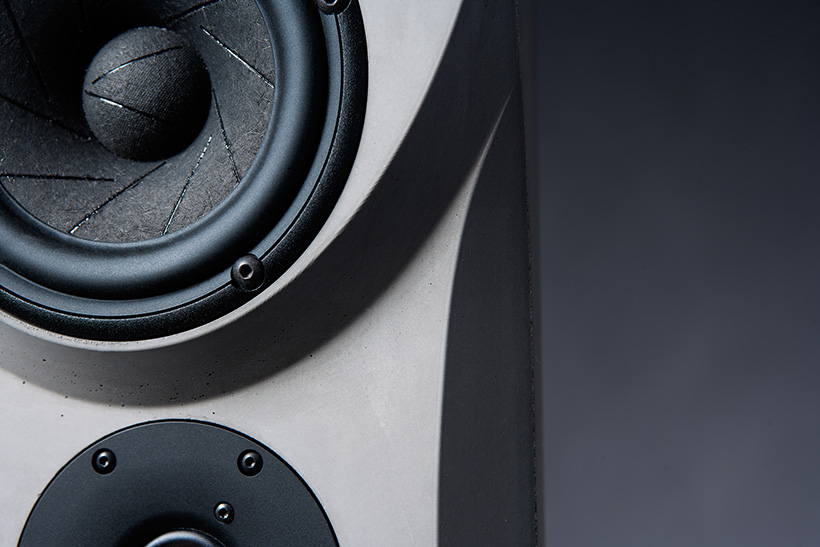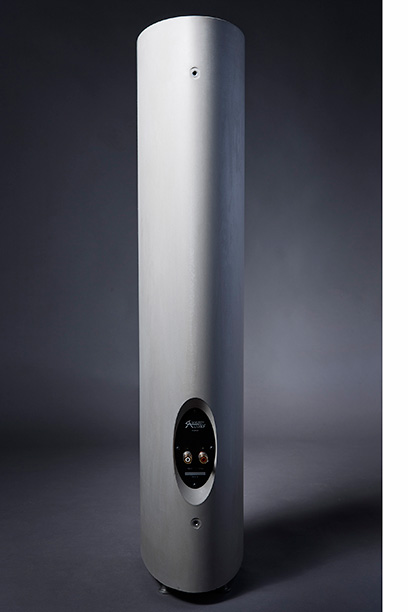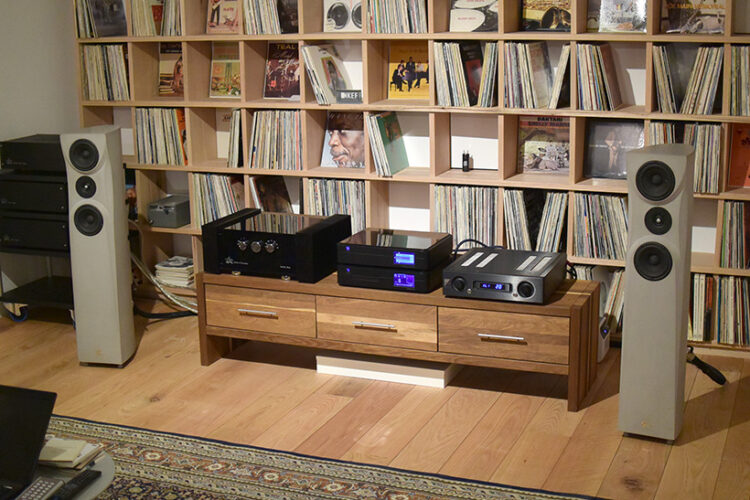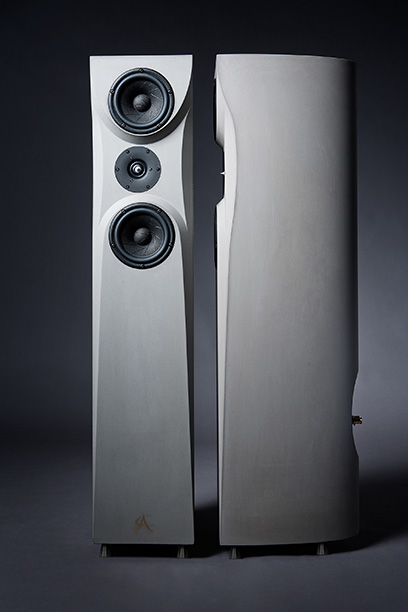Loudspeakers come in many materials but not often concrete. In Germany high end audio gets extreme and in Weimar a company is building concrete loudspeakers. Heavy and beautifully made they have real designer appeal and real mass. Investigating the Concrete Audio N1 speakers at home was not an option, they weigh 80 kilos each and I live in a third floor apartment without a lift. So I went to Rotterdam to visit a well-known dealer, Multifoon which has these speakers on demonstration. A system was put together with the PS Audio PWT transport and the DSD D/A converter with an Ayre Acoustics AX-5 integrated amplifier and AudioQuest cables. The large listening area at Multifoon is divided in two using acoustic damping panels. These panels are also found on the ceiling and side walls to reduce echoes, without making the listening area over damped. The loudspeakers stand at least a metre away from any wall, and a little more than three metres apart. The listening position was intended to be four metres measured from the baffles, but the room acoustics and the Concrete Audio N1 forced meant that optimum results were found when sitting only 3 metres away. This may be due to the room, but I suspect the D’Appolito arrangement of the N1 is also a factor.

The N1 is made out of concrete, monolithically poured and hand finished for a very smooth look and feel. Concrete is not only very hard, but also extremely stiff and of course heavy which is why Concrete Audio consider it the ultimate cabinet material. It has taken years to come up with a mixture that looks acceptable in modern interiors and delivers high end sound. For the drivers they have chosen a D’Appolito arrangement, with the tweeter set back for optimum phase response. The tweeters are offset to limit baffle edge reflections. Just as in most loudspeakers damping material is applied inside the box. We are dealing with a closed box, not a bass reflex or transmission line, and expensive Scan-Speak drivers, Mundorf filter components, Kimber cabling and WBT terminals. The slope of the cross-over is 6dB at 2kHz and with the woofers run in parallel which results in a low nominal impedance of 4 Ohms. The sensitivity of 83dB/W/m combined with this load means they need amplifier capable of delivering a lot of current. The soft grey tone of the cabinet and its slim form make them very suitable for a living room despite the material but the weight makes them tricky to move.
Serious listening
After moving my chair to the best position for serious listening I started with a Belgian singer called Micheline van Hautem, who translated well-known Dutch songs into French on her solo album Crème de la Crème. Her voice is very distinct and easy to remember, the recording is very good and her musicians use acoustic instruments most of the time. I won’t bother you with song titles but will get straight to the excellent results like an expressive voice that’s anchored in the soundstage. It’s positioned in front of the musicians, playing guitar that reveals a lot of string and guitar body character. Dynamics, even on higher volume settings, are easy for this system, the Ayre amp is clearly capable of delivering enough power. The bass is very tight, with no a trace of a typical bass reflex bump. High frequencies are clear without distortion. The voices from the background vocals are nicely separated from each other, while the physical speakers seem to disappear. I get the feeling I’m listening to near field monitors, the sound is that fast and very direct. On my old favourite Mary Black singing live about the ‘Crow And The Cradle’, the acoustics of the concert hall are clear, while the movements of Mary to and from the microphone are striking. The stage is wide, high and deep, this time the near field impression is a lot less. When the public applauds I hear many separate hands in the audience and their positions are easy to determine. It also strikes me that a small movement of my head can alter the sound. I wonder if this is due to the speaker or to the room. Since I am not familiar with either I cannot answer that question, but I need to mention this since it is so obvious.
 |
|
An Italian artist enters the room, Paolo Conte is a swinging singer with rhythm. His voice is well defined and uncoloured. Instruments like piano, bass, kazoo and brass instruments sound dynamic and open. The bass is fast and offers a lot of punch. In fact it’s almost limitless in power with not a trace of driver compression. Eva Cassidy’s Wade In The Water shows tiny faults in the recording process, proving that the Concrete Audio loudspeakers would be excellent studio monitors, they bring you lots of detail, although not in the hard or edgy way that real monitors do. Finger snaps sound very natural and come from a position outside of the speakers. On the King Singers’ version of Money, Money, Money the acappella singing gents sometimes have a microphone each, sometimes move in pairs to one microphone. I’ve never heard this so clearly. Before I move on to more classical work Ray Brown and Laurindo Almeida play Spanish guitar and bowed bass. The movement of the strings is obvious and sounds separate from the guitar or bass itself. The guitar is tender and engaging, no resonances are heard and not a single note fails. Turning to a steel guitar makes clear that the differences between these guitar types are as well defined as could be.
I would like to applaud to Cecilia Bartoli’s renditions of the songs of the late Maria Malibran, Saint-Saëns Dance Macabre on the Crystal Cable label and last but not least Janine Jansen in a work from Schubert for a string quintet. Although these three parts differ in many ways, it is clear that the N1 loudspeakers do their utmost to entertain the listener. A large orchestra is handled with ease, with plenty of power and great dynamics. This is also true for Bartoli’ s singing. She fills my heart with joy, dragging me into the performance with a lively presentation that’s replete with detail. Concrete does an excellent job at keeping the speaker cabinets quiet, reducing resonance means more detail and wider dynamic range. The relatively small woofers and low efficiency is really amazing, given the size of the room I expected a loss of impact, on the contrary, they deliver a full blown orchestra. They may not impress like big Tannoy Westminsters or Klipschorns, but Scanspeak nevertheless manufactures great woofers. It is not only power that counts, Janine Jansen shows how romantic Concrete Audio can sound given the right music. This makes a very emotional impression thanks to excellent speed that lets the violin sound as tender as can be. The mix of properties makes clear that while the €32,000 asking price may be high, for many of us far too high, somehow the concrete loudspeaker is worth the money. That is if you have the room, if you can afford a pair and if you are willing to invest in a high end system.

Impressions
This is not a real review, it is an impression of the capabilities of the Concrete Audio N1 loudspeakers. I would need a couple of weeks with my own system, in my own room, to offer a more in-depth report. Nevertheless it was clear to me that this is a great system with enormous potential. The purity and low distortion levels of these loudspeakers are exceptional, probably mostly due to the cabinet material. The use of concrete is not new, for instance many Karlsson resonators were built in the past from concrete (as were Electrofluidics in the nineties, Ed.). Concrete Audio not only shows that this material does not have to look industrial and rough, they also show us that an acoustically dead cabinet doesn’t necessarily sound dull or shut-in. On the contrary they produce a lively soundstage. Add a high class source, bring in a fine amp and treat yourself with music. These concrete speakers may not be available in a nearby shop, but like a Michelin approved restaurant they are worth travelling for.



